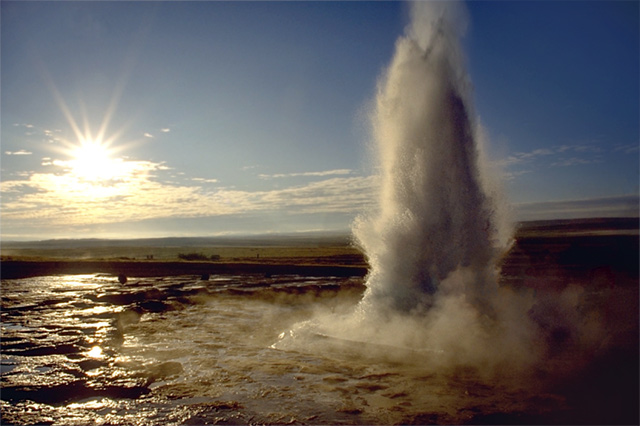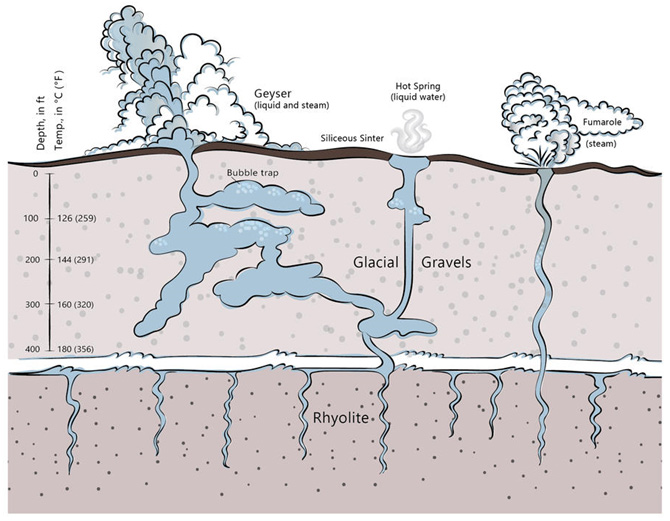
Credit: Andreas Tille (GFDL [http://www.gnu.org/copyleft/fdl.html] or CC BY-SA 3.0 [http://creativecommons.org/licenses/by-sa/3.0]), via Wikimedia Commons
For centuries, geysers have captured our imagination, in places like Yellowstone National Park, where 4 million visitors flock each year.
This is partly because geysers are spectacular, and partly because they’re rare. There are only about 1,000 worldwide, and nearly half of them are in Yellowstone. Most others occur in just five countries.
Why are there so few? They require very specialized geology.
At the surface, they need caprock, to trap water. In the subsurface, they need fissures in the rock, so water can flow into and collect in reservoirs and cavities.
Below that, they need intense heat—all geysers are in volcanic areas.
The bottom of the geyser’s water column is closest to the heat, under higher pressure—which raises the boiling point. So the water keeps heating without converting to steam.
The heat travels up the water column, eventually reaching the top. There, the pressure is lower, so the water can boil.
As it turns to steam, it releases pressure on the water just below it. Which can now boil, releasing pressure on the water further down, and so on. This chain reaction produces huge volumes of steam, which erupt out the top of the geyser.
In large geysers, steam can carry thousands of gallons of boiling water into the air, in fountains that can last a few seconds to a few hours and reach heights up to 300 ft.
If you go to see one, prepare to be amazed. It’s one of nature’s greatest shows.
Background
Synopsis: With their dramatic displays, geysers have always captured the imagination of humans. A thermal geyser is a rare kind of hot spring that episodically erupts water and steam. Geysers demonstrate the purest and most ancient exemplification of geothermal power.
- Geysers are rare. There are only about 1,000 geysers in the world, and about half are found in Yellowstone National Park in the United States. Others occur in Iceland, Kamchatka (Russia), Kenya, New Zealand, and Chile.
- The world’s most famous geyser is Yellowstone National Park’s Old Faithful, which erupts about every 90 minutes.
- Steamboat Geyser in Yellowstone National Park is the tallest existing geyser, with eruptions blasting more than 400 ft high, but it has only erupted sporadically 10 times over the past 20 years.
- New Zealand’s Waimangu Geyser was the tallest geyser in the world until a 1904 landslide altered its hydrology. Its eruptions were spectacular, some blasting jets of black water and rock up to more than 1,400 ft in the air. In 1903, four spectators lost their lives in a surprise eruption; their boiled bodies were recovered about a mile downstream.
- Geysers require a rare combination of special natural conditions in order to form.
- All geysers occur in areas of active magmatism where cooling magma in the subsurface is usually a few miles deep.
- Fountain geysers erupt from pools, and cone geysers erupt from mounds they build on Earth’s surface. Fumaroles vent steam directly to the surface.
- Geysers are more common at high latitudes.
- They require water recharge from abundant local or distant precipitation into the subsurface, and flow through fissures and cavities where they are heated.
- Deeper and larger cavities typically have larger and more regular eruptions, especially if they are hydraulically separated.
- Geysers that are interconnected in the subsurface influence each other, which tends to make them less predictable.
- Geysers typically occur where glacial deposits overlie SiO2-rich rhyolite flows or pumice deposits that provide a source for silica that is then deposited as a crusty sinter at the ground surface.
- Low-permeability caprock is necessary to trap fluids in the underground cavities.
- Eruptions are caused by decompression of the system as thermal energy is converted to kinetic energy. What happens during a geyser eruption?
- Before major eruptions, geysers may produce minor eruptions, indicating the show is about to start.
- Boiling in the geyser system initiates at the top of the water column.
- When the eruption starts, pressure decreases and the water flashes into steam that may be more than 2,000 times the volume of the liquid water.
- As the eruption progresses, boiling in geyser conduits propagates downward; steam generated at greater depths and in cavities enters the conduit until all the liquid water has converted to steam.
- The eruption ends when the pressure in the subsurface reservoir equals the atmospheric pressure.
- Geysers are fragile. If their water source is cut off or the configuration of the fractures and cavities is altered, eruption intervals may change or stop completely.
- Earthquakes and landslides have devastated numerous geysers.
- Reduced precipitation and water recharge can diminish the water source, slowing or ending the geyser’s flow.
- Geothermal-energy production impacts nearby geysers.
- Vandalism can destroy geysers.
- Do fossil geysers exist?
- Paleo-geyser systems would be very difficult to distinguish from fossil hot-spring systems in volcanic terrains.
- Fossil hot-spring deposits within ancient volcanic deposits are very rare because they are fragile and tend to be eroded from the landscape.
- Only a couple dozen possible hot-spring deposits have been documented from rocks older than the Pleistocene, although a few as old as Paleozoic have been documented.

Idealized cross section of a geyser, hot spring, and fumarole, and their underground workings in a typical geyser basin.
Credit: USGS public domain

